 The Royal Ecossais
This was a single battalion regiment formed in 1744 around a cadre drawn from various Irish regiments in French service, although there is some evidence that efforts were made to raise a second battalion while it was in Scotland. The regiment was transported from there in entirety and was lucky to lose only 60 officers and men en route when L'Esperance was captured off the Dogger Bank. The bulk of the Regiment landed at Montrose on 26th November 1745, and the detachment subsequently fought at Inverurie on the 23rd December 1745. The grenadier company and a fusilier picquet were at FALKIRK and according to d'Eguilles the regiment was still some 350 strong at CULLODEN. There it was commanded by Lieutenant Colonel Lord Lewis Drummond of Melfort and after a brave rear guard action they subsequently surrendered at Inverness on 19th April 1746. |
|---|
 The Braemar Standard The Braemar Standard was raised by the Earl of Mar in 1715. |
|---|
 Cameron of Glendessary Aye, this is my version of The Ruddy Banner. |
|---|
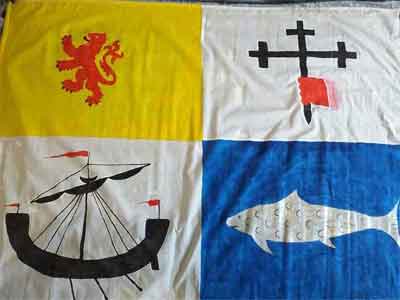 MacDonald of Keppoch's Regiment A small regiment with a sometimes unsavoury reputation for plundering and worse. Commanded by Alexander MacDonald of Keppoch, it served throughout the campaign, averaging about 200 men, including some MacKinnons and MacGregors. Keppoch was killed at CULLODEN and the remains of the regiment was disbanded at Fort Augustas on 18th April 1746. MacDonald of Glencoe's Regiment A very small unit of 120 men commanded by Alexander MacDonald of Glencoe. This unit joined the Jacobite army at Aberchalder to rendezvous on 27th August 1745. It served throughout the campaign attached to MacDonald of Keppoch’s Regiment and surrendered to General Campbell on 12th May 1746. Casualty list: 52 killed and 36 wounded. Instead of a conventional stand of colours there are reputed to have marched behind a bunch of heather tied to a pike. |
|---|
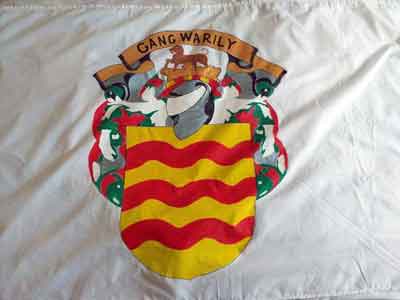 The Duke of Perth's Regiment Raised by James Drummond, Duke of Perth, in September 1745 and consisting of Highland and Lowland companies, English volunteers and former British Army personnel. 200 men fought at PRESTONPANS and this was increased by volunteers from Edinburgh along with the remains of Cope's Army. Some were used to garrison Carlisle Castle and in Scotland they were assigned to the blockade of Stirling Castle. The regiment was about 200 strong at CULLODEN where it was posted on the extreme left of the front line. In the aftermath of the battle James Drummond became very ill and died on 8th May 1746 on his voyage to France on the French Privateer "Le Mars". |
|---|
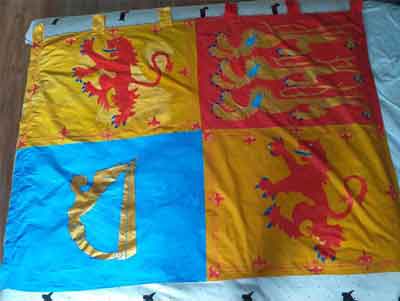 The Royal Stuart Banner of Scotland |
|---|
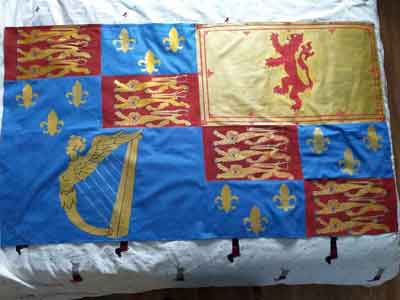 The Stuart Banner The banner of The Royal Coat of Arms of James 1 (James Charles Stuart: 19th June 1566 - 27th March 1625), the first and fourth quarters represent England and the English claim to the French throne, second quarter representing Scotland, the third quarter representing Ireland. |
|---|
 The Stuart Banner This is my version of the banner. The Coat of Arms portrays Scotland with the Red Rampant Lion of the House of Stuart in prominence. King James Vlll - "Here's to the King sir, aye ye ken wha a mean, sir". Nemo Me Impune Lacessit (nobody touches with impunity). |
|---|
 Sir James Kinloch, commander of Ogilvie's Second Battalion |
|---|
 The Earl of Cromartie's Regiment Raised in the northern highlands after PRESTONPANS by George MacKenzie, Earl of Cromartie and his son John MacKenzie, Lord MacLeod, and very substantially made up of MacKenzies. This was not a clan levy as some of the men were tenants and followers of Cromartie. A mixture of volunteers and pressed men approximately 200 strong at FALKIRK, it was sent north in search of French Gold and supplies where it was ambushed and destroyed in a running fight with Loyalist Militia at Embo near Golspie on 15th April 1746. |
|---|
 Chisholms of Strathglass This was a very small unit. An independent company of no more than 80 men and was led by Roderick Og Chisholm. It joined the Jacobite Army in March 1746 and then reputedly suffered very heavy casualties at CULLODEN where it was effectively destroyed. |
|---|
 Cameron of Locheil's Regiment The first of the Clans to raise support for The Prince, the regiment was one of the strongest Jacobite units. Donald Cameron of Locheil brought some 750 clansmen to the gathering at Glenfinnan on the 19th August 1745. At PRESTONPANS they were 500 strong. The clan was reinforced by Ludovic Cameron of Torcastle who levied out a further 300 men. The Clan Cameron regiment was about 700 strong at CULLODEN and although suffering heavy losses in the battle it was not disbanded until 27th May 1746. |
|---|
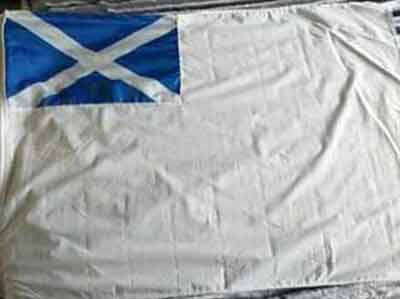 Bannerman of Elsick's Regiment This was a very small regiment of 150 men raised in the Stonehaven area just south of Aberdeen by Sir Alexander Bannerman of Elsick. After PRESTONPANS this regiment was largely employed on internal security duties. Finlayson's map of CULLODEN shows them deployed at the left rear of the Jacobite Army next to King's Stables. |
|---|
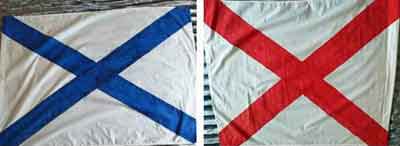 The Athol Brigade The brigade consisting of three battalions under the command of The Duke of Atholl - the battalion commanders were Lord Nairne, the Hon. Robert Mercer of Aldie and Lord George Murray. The latter being made Lieutenant General of The Jacobite Army by the Prince at Perth. The Brigade consisted of The Duke of Atholl's men and those of Sir Robert Menzies of Weems, under Menzies of Shian and of Duncan Robertson of Stuan's men, under Donald Robertson of Woodshiel. Lord Nairne had raised a unit of 250 men from the Dunkeld area and joined the Prince at Holyrood on 18th September 1745 and was present at PRESTONPANS. They were in the reserve column and the Prince attached himself to this force when the Jacobite Army marched in silence over the marshland the night prior to the battle. The Duke of Atholl eventually succeeded in joining the Prince on 30th October before the march into England. At the Battle of Falkirk the three battalions were commanded by Lord George Murray and they alone of the second line kept their ranks throughout the battle. Being led by their commander, who had decided to press home their advantage, they advanced downhill in perfect order. Lord George determined to harass the fleeing enemy who had been seen running off in the direction of FALKIRK. The brigade was about 900 strong at FALKIRK. On 12th March Lord George left Inverness with 600 - 700 of the brigade, his destination was Blair Castle and its recapture. They were joined by 300 MacPhersons under Cluny at Ruthven Barracks. They besieged the castle on 17th March and were recalled to Inverness prior to the Battle of CULLODEN, where the battalion was posted to the extreme right of the front line. When the retreat was called the right wing retreated in order, Lord George took the road to Ruthven in Badenoch. Both Menzies of Shian and Mercer of Aldie were killed at CULLODEN; Lord George escaped to Holland and died there in 1760. |
|---|
 John Gordon of Glenbuchat's Regiment 300 men were raised from Strahdawn, Glenlivit and Strathboggy - all parts of The Duke of Gordon's estate. His son-in-law, Lieutenant Colonel George Forbes of Skellater brought some of his Corp from Strathdon, formerly vassals of the Earl of Mar now Lord Braco. The Regiment was not present at FALKIRK being assigned to the Siege of Stirling Castle and was present at CULLODEN and in the aftermath was probably disbanded at Ruthven Barracks on 18th April 1746. |
|---|
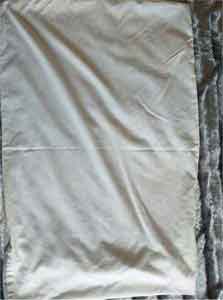 Lord Lewis Gordon's Regiment This large regiment was raised in Aberdeenshire and Banffshire after PRESTONPANS by Lord Lewis Gordon, a naval officer and son of the Duke of Gordon. The commanding officers were Francis Farquharson of Monaltrie, John Gordon of Avochie and James Moir of Stonywood - all had plain white colours. |
|---|
 Lord Lovat's Regiment The Clan Fraser was formed into three regiments, commanded by The Master of Lovat, Charles Fraser of Inverallochie, and by James Fraser of Foyers. The latter certainly commanded the force that unsuccessfully attacked Culloden House on 27th October 1745 but it was afterwards taken over by the elderly son of Lord Lovat, The Master of Lovat. About 300 men fought at FALKIRK and Inverallochie's battalion had about the same at CULLODEN, but the Master of Lovat's battalion 'missed' taking part in the battle by a matter of hours and probably disbanded later that day having surrendered on the field to James Wolfe, officer of Barrell's regiment of foot. Charles Fraser was mortally wounded on the field. |
|---|
 Lord Ogilvy's Regiment A large and well disciplined unit raised in the Forfarshire area by David Lord Ogilvy, the eldest son of the Earl of Airlie. The first battalion, some 200 strong, joined the Jacobite Army at Edinburgh after PRESTONPANS and served throughout the rest of the campaign. While the army was in England a second and larger battalion was raised by Sir James Kinloch and some of these recruits took part in skirmishes with government troops around Montrose and Inverurie. Both battalions served together at FALKIRK and at CULLODEN. After the army dispersed at Ruthven Barrack's on 19th April 1746 they continued home as a military unit before eventually disbanding in Glen Clova on the 21st April. Two colours are associated with the battalions, one bearing a Saltire and the other the Kinloch Arms. |
|---|
 Lord KIlmarnock's Footguards Formed March 1746, this was a mixture of dismounted cavalry units of Lord Kilmarnock's Horse and Lord Pitsligo's Horse with James Crichton of Auchingoul's Regiment and with new recruits from Aberdeenshire forced out by Kilmarnock's formidable mother-in-law Lady Erroll. |
|---|
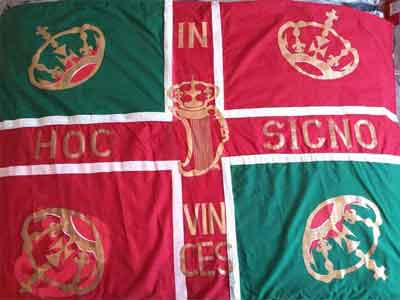 Irish Piquets Initially on 12th October 1745 a treaty was signed at Fontainebleau by the Marquis d'Argenson on behalf of King Louis XV and a Jacobite agent, Colonel O'Bryan, formally committing the French Government to providing direct military aid to the 'rebels'. The French auxiliaries serving with the Jacobite army fell into two basic categories. As might be expected, professional assistance was not confined to the Artillery and a surprising number of individual officers acted as military advisers and instructors, the most important of whom was Colonel John William O'Sullivan. Initially one picquet or detachment was embarked from each of the six Irish regiments in the French service. According to the 1750 regulations, which established practice, a picquet was a sub unit of company size comprising a captain, a lieutenant, two sergeants, a drummer and 47 men. In the event only three such picquets made it to Scotland. Drawn from the Regiments of Dillon, Rooth and Lally, they were formed into a small provisional battalion. They served at FALKIRK, the sieges of Fort Augustas and Fort William and finally at CULLODEN where they provided a brave rear guard action to save the Jacobite left wing being overrun by Kingston's and Cobham's dragoons. |
|---|
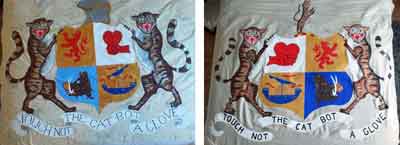 Lady Anne Macintosh's Regiment Sometimes referred to as the Clan Chattan Regiment, this was a fairly large formation; it was raised in the Inverness area by Lady Mackintosh and commanded by Alexander McGillivray of Dunmaglass. About 300 strong at FALKIRK, and around 350 strong at CULLODEN it was effectively destroyed there, losing most of its officers. The Clan Chattan led the 'charge' breaking into Barrel's regiment on the government left, very few of them survived but the Colours were saved by Donald Mackintosh who took them from the fallen standard bearer wrapped them round his body and escaped the field. There are two versions of the flag. |
|---|
 MacDonald of Clanranald's Regiment Three companies were present when the Standard was raised at Glenfinnan on the 19th August 1745. About 200 men fought at PRESTONPANS under Ranald MacDonald, younger of Clanranald. Reinforcements brought it up to 350 strong at FALKIRK but only 200 were present at CULLODEN where Clanranald was wounded. The regiment was disbanded at Fort Augustus on or about 18th April 1746. |
|---|
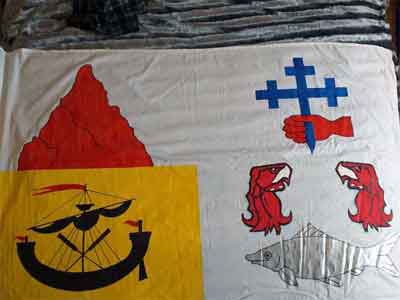 MacLachlans and MacLeans Commanded by Lachlan MacLachlan of Castle Lachlan, they joined the Jacobite army at the outset as did a small company commanded by Captain John MacLean of Kingairloch. The two contingents were combined and they went through most of the campaign attached to Lord Nairne's Regiment of the Athole Brigade. In March 1746 they were joined by a further contingent of MacLeans under Charles MacLean of Drimnin, they fought for the first time as an independent unit at CULLODEN apparently fielding around 200 men under the command of MacLachlan with Drimnin as lieutenant colonel. Their position was front centre of the Jacobite line, MacLachlan was killed early in the battle while Drimnin rallied his troops, killing one dragoon and wounding another before he was mortally wounded. |
|---|
 The Manchester Regiment The Manchester Regiment was formed around a nucleus of English officers and men from the Duke of Perth's Regiment. On 30th November (St Andrew's Day) recruits were speedily enrolled into the Jacobite army. Command was given to Colonel Francis Townley who had formally been commissioned in the French Service and had joined the Prince in Preston. The regiment never exceeded 300 men and accompanied the Prince to Derby and then back to Carlisle Castle. There were many desertions and what was left became part of the garrison left to defend Carlisle. The garrison surrendered to Cumberland on 30th December 1745. Being Englishmen they were singled out for bloody revenge from the government. Nearly all the officers and sergeants were hanged for treason and the other men were transported to the colonies. Colonel Francis Townley was executed on Kennington Common on 30th July 1746. At Townley's trial a witness testified that the regiment's colours had the words 'Liberty and Property' on one side and 'Church and Country' on the other, possibly on a St George's cross. |
|---|
 The Stewarts of Appin About 200 men under Charles Stewart of Ardshiel joined the Jacobite Army at Invergarry on 29th August 1745 and served throughout the campaign. The unit was particularly prone to desertion as it was 350 strong at the outset of the march into England but could only muster 300 men at FALKIRK despite having been joined at Stirling by 150 fresh men under Alexander Stewart of Invernahyle. The unit was just 250 strong at CULLODEN a casualty list compiled by Ardsheal reveals that the Regiment lost 90 killed and 65 wounded although it is unclear if this relates to CULLODEN alone or, more likely, the whole campaign. A Blue Colour bearing a Yellow Saltire survives due to the bravery of Donald Livingstone (Domhnull Molach or Hairy Donald) who turned back under heavy fire to rescue the Appin banner. The original is on display at The National Museum in Edinburgh. |
|---|
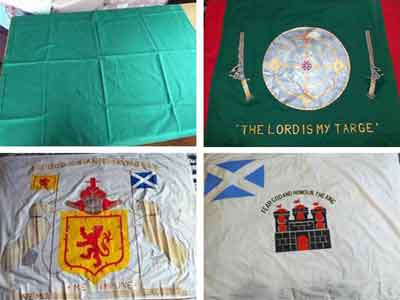 John Roy Stuart's Regiment John Roy Stuart's Regiment, also known as the Edinburgh Regiment, was initially recruited in the city by Stuart, an experienced soldier who was a captain of grenadiers in the Royal Ecossais at the time. The Regiment took part in the march to Derby, but was not present at FALKIRK, being assigned instead to blockade Stirling Castle. At CULLODEN it was about 200 strong, eventually standing in the front line next to the Stewarts of Appin. Three colours are associated with this regiment. The Green Flag of Kincardine; the Green Flag with the famous Targe and Doune pistols with the motto 'The Lord is My Targe'; a Colour bearing the Stuart Arms; and a fourth bearing the legend 'Fear God and Honour the King'. The Green Flag being rescued from the field by James Mclntyre of Beglan, the standard bearer of Colonel John Roy Stuart. Every year at the Raising of the Standard at Glenfinnan on August 19th he carried the flag to the top of Cairngorm in commemoration of John Roy Stuart's Regiment. |
|---|
 The Strathboggle Battalion John Gordon of Avochie's battalion, known as The Strathbogie Battalion of Lord Lewis Gordon's Regiment. About 300 strong, this battalion served at Inverurie, FALKIRK and CULLODEN. It was disbanded at Ruthven Barracks on 18th April 1746. Lord Lewis Gordon's Regiment, apart from the above, consisted of Farquharson of Monaltrie's Mar battalion and James Moir of Stonywood's battalion. A number of references state that all battalions had plain white colours. |
|---|
 MacDonnell of Glengarry's Regiment MacDonnell of Glengarry's Regiment joined the Jacobite Army at the Aberchalder rendezvous on 27th August 1745. 400 strong at Gladsmuir this included 80 Grants from Glenmoriston and Glen Urquhart. Later in the campaign they were joined by a small contingent of MacLeods of Raasay. After young Glengarry was accidentally shot at FALKIRK the command was given to Donald MacDonnell of Lochgarry. 500 strong at CULLODEN the last remnants of the regiment was disbanded on 27th May 1746. |
|---|
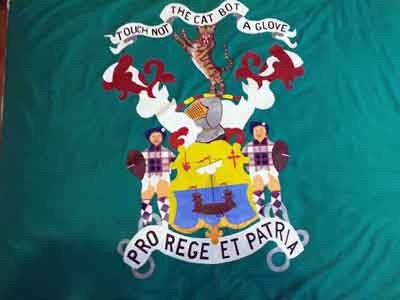 Cluny MacPherson's Regiment Ewan MacPherson was a Captain in Loudon's 64th Highlanders at the beginning of the '45' rising but quickly changed sides after the Battle of Gladsmuir and took part in the march to Derby. The regiment fought at Clifton Moor and was reported to be about 400 officers and men strong at FALKIRK. The Regiment was not present at CULLODEN and surrendered to the Earl of Loudoun on May 17th 1746. Cluny remained in hiding for many years before leaving for France in 1755. This is a replica of their flag 'Am Bratach Uaine'. |
|---|
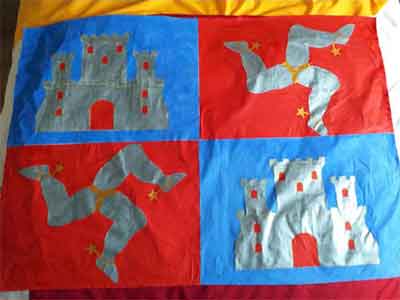 The MacLeods of Raasay Regiment Colonel Malcolm MacLeod, the 10th Chief, and his cousin Donald MacLeod of Beneray came out in support of Prince Charles Edward Stuart and raised upwards of 40 men. They joined the Jacobite Army at Stirling in January 1746. At the Battle of FALKIRK MUIR they fought alongside Glengarry's Regiment and were with the Regiment at CULLODEN where Raasay's second son Dr Murdoch was wounded. The men fled back to Skye after the battle and in the aftermath a dozen or so were taken prisoner and five were transported. Malcolm MacLeod of Eyre in Raasay was the man who helped the Prince, conveying him from Portree to Elgol on the night of 3rd - 4th of September 1746. Malcolm was captured on Raasay on 17th September and jailed in London He was eventually pardoned in 1747. His home and the island of Raasay were ravaged by Capt Ferguson (of the royal navy). |
|---|
 Clan Macgregor On the 30th August 1745 John Macgregor of Glengyle, Evan Macgregor of Glen Cannock and James Mor and Ronald, two sons of Rob Roy Macgregor, met the Duke of Perth at Balquidder and resolved to raise a troop of their men to serve the Jacobite Cause. They joined forces with Prince Charles Edward Stuart at Callander. |
|---|
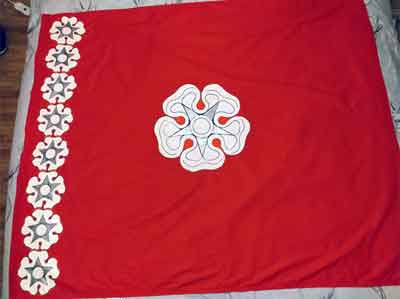 A Jacobite Banner I believe this banner depicts Prince Charles Edward Stuart and his 'Seven Men of Moidart' who landed in Scotland to raise the Clans in support of his father King James Vlll, the rightful heir to the throne. |
|---|
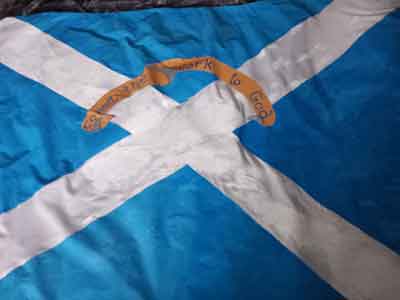 Cromartie's Regiment This Jacobite Flag is a reproduction of one of the captured standards on Major Hu Wentworth's list. This is noted by Wentworth as an unknown unit but attributed to Cromartie's Regiment. |
|---|
 Colonel Gardiner's 13th Dragoons The cavalry guidon of Colonel Gardiner's 13th Dragoons was captured at FALKIRK by Lord Elcho's Lifeguards. John Daniel then carried the guidon at CULLODEN where he described it as "a curious fine standard with the motto 'Britons Strike Home' ". The design of this flag is based on British military flags on the 1747 regulations. Daniel hid the standard in his riding coat at the rendezvous at Ruthven, but it was taken from him by two Irish Piquets on board a boat taking them to France. |
|---|
